Scientific experiment conducted by Maharshi Adhyatma Vishwavidyalay using a UTS (Universal Thermo Scanner)
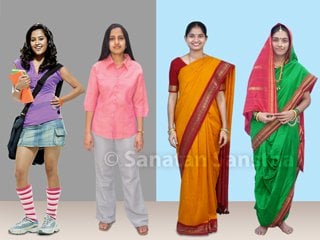 Clothes such as jeans, t-shirt, churidar, etc. that have come from foriegn culture have become an inseparable part of the lifestyle of most Hindu women today.
Clothes such as jeans, t-shirt, churidar, etc. that have come from foriegn culture have become an inseparable part of the lifestyle of most Hindu women today.

In contrast, the traditional 9-yard sari, which is the identity of the Hindu culture, is mostly restricted to villages. An individual’s clothing unknowingly affects his/her personality. By wearing Raja-Tama-predominant clothes (such as a t-shirt, jeans, etc.) that are prevalent in the present times, the woman’s personality becomes conceited and materialistic; whereas, by wearing sattvik (Spiritually pure) clothes such as a 6-yard or 9-yard sari, the woman’s personality becomes virtuous and Dharma-abiding. Abiding by Dharma develops bhav (Spiritual emotion) of devotion unto God and this marks the commencement of the individual’s journey towards God-realisation.
Maharshi Adhyatma Vishwavidyalay conducted a scientific experiment with the help of a UTS in August 2018 at Sanatan’s Ramnathi Ashram in Goa to find out the spiritual effect of wearing non-sattvik clothes as per foreign culture and sattvik clothes as per the Hindu culture on a woman. The nature of the experiment, observations and their analysis are presented here.
1. The nature of the experiment
In this experiment, a lady-seeker who was suffering from severe spiritual distress (Note) wore 5 sets of foreign tradition dresses mentioned ahead, one per day.
1. A dress worn in a particular sect
2. A white evening gown (long)
3. A black tube-top dress
4. A t-shirt & black pant
5. Salwar-kurta (Traditional Indian)
On the sixth day, this lady-seeker wore a 6-yard sari and the following day she wore a 9-yard sari as per the Hindu culture. She wore each set of clothing for 30 minutes. In this experiment, before and after the lady-seeker wore the clothes, UTS readings were recorded every day and a comparative study of these readings was done.
Note – Spiritual distress : Having spiritual distress means the concerned individual has negative vibrations. If these vibrations are 50% and above, the distress is ‘severe’, between 30% and 49%, it is ‘moderate’ distress, and less than 30% is ‘mild’ distress. Spiritual distress is caused due to spiritual reasons such as destiny, distress due to ancestors. Saints or seekers who have subtle perception ability can analyse this spiritual distress.
Note for readers : Due to shortage of space we have given the common features of UTS on goo.gl/f2n2JW (Please note that some letters are in Caps) – Introduction to UTS, Various components of the scientific experiment conducted with the instrument and description, Measuring the aura of an object using the UTS, Procedure and precautions taken for consistency in the readings, Tabulated observations, etc.
2. UTS observations and their analysis
2A. Analysis of the observations pertaining to negative energy
2A 1. Infrared energy in the lady-seeker who was suffering from severe spiritual distress increased upon wearing a dress of a particular sect, a white evening gown, a black tube-top dress and a t-shirt & black pant; however, when she wore a salwar-kurta the negative energy in her was completely eliminated
Before wearing the clothes, infrared energy was present in this lady-seeker. During the experiment to test the presence of negative energy, the arms of the UTS scanner opened at an angle of 1800, clearly indicating the presence of negative energy in her and hence, the aura of this energy could be measured. The infrared and ultraviolet energies are considered to be negative energies by the UTS scanner. The UTS readings that show an increase in the negative energy in the lady-seeker upon wearing clothes belonging to foreign culture are given ahead.
Table A
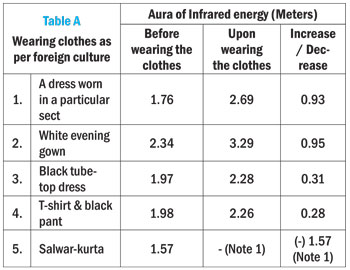
Note 1 – Upon wearing the salwar-kurta, the infrared energy in the lady-seeker who was suffering from severe spiritual distress was completely eliminated. Hence, the aura of this energy reduced by 1.57 meters.
2A 2. The ultraviolet energy in the lady-seeker who was suffering from severe spiritual distress increased upon wearing the clothes of a particular sect, a white evening gown, a black tube-top dress, and a t-shirt & black pant; however, upon wearing a salwar-kurta, negative energy in her was completely eliminaed :Before wearing the clothes, the ultraviolet energy was present in this lady-seeker. The UTS readings of increase in the ultraviolet energy in the lady-seeker upon wearing clothes as per foreign culture are given ahead.
Table B
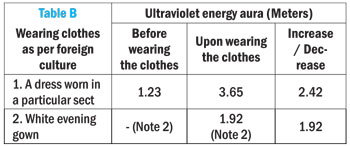
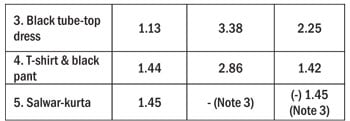
Note 2 – Before wearing the white evening gown, there was no ultraviolet energy in the lady-seeker who was suffering from severe spiritual distress; however, upon wearing this dress, ultraviolet energy was created in her.
Note 3 – Upon wearing the salwar-kurta, the ultraviolet energy in the lady-seeker was completely eliminated. Consequently, the aura of this energy reduced by 1.45 meters.
From the above mentioned aspects, it is realised that upon wearing the clothes of a particular sect both the types of negative energies increased significantly in the lady-seeker who was suffering from severe spiritual distress.
2A 3. Negative energy in the lady-seeker who was suffering from severe spiritual distress was completely eliminated upon wearing a 6-yard and 9-yard sari
In the beginning, the infrared and ultraviolet energies were present in the lady-seeker who was suffering from severe spiritual distress. Upon wearing a 6-yard and 9-yard sari, these negative energies in her were completely eliminated.
Table C
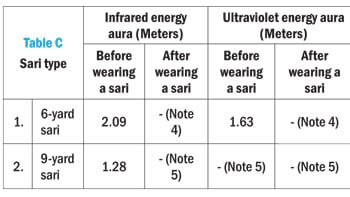
Note 4 – When the lady-seeker wore a 6-yard sari, the infrared and ultraviolet energies in her were completely eliminated.
Note 5 – Before wearing the 9-yard sari, only the infrared energy was present in the lady-seeker (amongst the infrared and ultraviolet energies). After wearing the 9-yard sari, the infrared energy in her was completely eliminated.
2B. Analysis of the observations pertaining to positive energy
2B 1. No positive energy was found in the lady-seeker who was suffering from severe spiritual distress; moreover, positive energy was not created in her when she wore clothes of a particular sect, a black tube-top dress, a white evening gown, and a t-shirt & black pant, but, upon wearing the salwar-kurta, positive energy was created in her
It is not necessary that every individual, object or premises will have positive energy. No positive energy was found in the lady-seeker who was suffering from severe spiritual distress before the experiment. No positive energy was created in her when she wore clothes of a particular sect, a black tube-top dress, a white evening gown, and a t-shirt & black pant. However, upon wearing the salwar-kurta, positive energy was created in her and the aura of this energy was 1.29 meters.
2B 2. Upon wearing a 6-yard or a 9-yard sari, high amount of positive energy was created in the lady-seeker
No positive energy was found in the lady-seeker who was suffering from severe spiritual distress before the experiment. Upon wearing a 6-yard or 9-yard sari, significant amount of positive energy was created in her and its aura was 2.33 meters and 3.58 meters respectively.
2C. Analysis of the observations
pertaining to the total measured aura
2C 1. The total measured aura of the lady-seeker who was suffering from severe spiritual distress increased to the utmost extent upon wearing the clothes of a particular sect (amongst all the clothes from foreign culture); whereas, her total measured aura marginally increased upon wearing the salwar-kurta
Generally, the aura of an individual or object is one meter. Increase in the total measured aura of this lady-seeker upon wearing clothes as per foreign culture is given ahead.
Table D
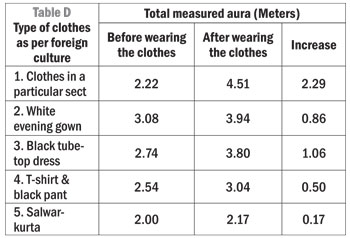
2C 2. The total measured aura of the lady-seeker who was suffering from severe spiritual distress increased significantly upon wearing a 9-yard sari
Table E
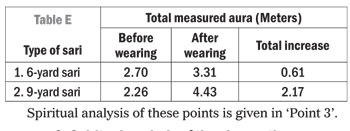
3. Spiritual analysis of the observations
3A. Possibility of negative energies
(Note) entering the body through the
medium of the clothes as per foreign culture since
they are Raja-Tama-predominant and upon wearing
these, creation of distressing vibrations in the environment
shirt, Punjabi dress (here, the salwar is loose), churidar (here, the salwar is pleated and fits snugly on the legs), gown, etc. are Raja-Tama-predominant; therefore, the possibility of negative energies entering the body through these clothes increases. Additionally, distressing vibrations are also created in the environment upon wearing these clothes. When compared with these foreign clothes, a somewhat sattvik (Spiritually pure) dress salwar-kurta has become so prevalent in the Hindu culture that Hindus have enthusiastically embraced it as their own !
Note – Negative energies : Positive as well as negative energies are active in the environment. Positive energies assist humans in performing virtuous tasks and negative energies cause distress. There are many stories in the Vedas and Puranas about demons creating obstacles in the Yajnas (Ritual of acrificial fires) of Sages and Ascetics in the ancient times.
3B. Upon wearing a sari, the Shakti
(Divine Energy) Principle in the woman getting
awakened and its proportion fluctuating as per her bhav
A sari worn by a woman helps activate the Shakti Principle in her. By wearing a Punjabi dress (Salwar-kurta), this active Shakti remains in a dormant state in the gross body. Upon wearing a sari, the active Shakti is created to a diameter of 5 feet around the gross body of the jiva (Embodied soul). Its proportion increases or reduces as per the bhav of the jiva. – Mrs. Ranjana Gautam Gadekar, Sanatan Ashram, Ramnathi, Goa.
3C. Upon wearing a 9-yard sari,
the woman’s five vital energies became
active and Chaitanya spread throughout her body
When compared with other clothes, since the 9-yard sari has many layers, the sari has greater capacity to imbibe, emit and retain Chaitanya (Divine consciousness) as per the need. The inner layer of the folds of a 9-yard sari performs the function of retaining Chaitanya, the middle layer imbibing Chaitanya, and outer layer emitting Chaitanya. Due to the Chaitanya accumulating in the knot of a 9-yard sari near the waistline, the five vital energies near the Manipur-chakra (Spiritual energy centre located at the navel) get activated by coming in contact with this Chaitanya, and slowly it spreads in the whole body.
– A Scholar, 6.5.2005 (Sanatan’s Sadguru [Mrs.] Anjali Gadgil writes under the pseudonyms of ‘A Scholar’, ‘Gurutattva’ etc.)
3D. Negative energy in the
lady-seeker who was suffering
from severe spiritual distress increasing
significantly upon wearing non-sattvik clothes
(such as clothes of a particular sect, a white evening
gown, a black tube-top dress and a t-shirt & black pant)
From the above mentioned aspects we learnt that negative vibrations in the environment get attracted to non-sattvik clothes. Clothes as per foreign culture (such as clothes of a particular sect, a white evening gown, a black tube-top dress and a t-shirt & black pant) are non-sattvik; therefore, upon wearing these, negative vibrations got attracted towards the lady-seeker who was suffering from severe spiritual distress to a greater extent. The harmful effects of these clothes on the lady-seeker are given ahead.
1. This lady-seeker suffers from severe spiritual distress. To begin with, negative vibrations were already present in her. When she wore the non-sattvik clothes of a particular sect, negative vibrations were attracted to her in a greater extent. Hence, negative vibrations in her increased significantly.
2. These negative vibrations were added to her total measured aura and as a result, her total measured aura increased after wearing non-sattvik clothes (Table D).
3. She suffered most damage upon wearing clothes of a particular sect. The reason is that these clothes are black and cover the entire body. As a result, maximum amount of negative vibrations were attracted to these clothes. In this experiment, we found that the harmful effect of wearing a black tube-top dress, a white evening gown and a t-shirt & black pant on this lady-seeker was in a descending order (Last column in Table D).
3E. Effect of wearing a salwar-kurta, which is
comparatively more sattvik than other foreign clothes
Upon wearing a salwar-kurta, which is comparatively more sattvik than other foreign cothes, the lady-seeker obtained Chaitanya to some extent; hence, negative energy in her got eliminated and positive energy was created in her. Negative vibrations from her total measured aura were eliminated and positive energy was created in her, and as a result, her total measured aura increased marginally.
3F. It is because of the
significant Chaitanya obtained
upon wearing a 6-yard and 9-yard sari,
that the lady-seeker received spiritual benefits
such as negative energy in her getting eliminated,
significant amount of positive energy getting created and
her total measured aura increasing and the benefits obtained
from the 9-yard sari were more than that from the 6-yard sari
A 6-yard sari is sattvik. A 9-yard sari is more sattvik than a 6-yard sari. Positive vibrations (Chaitanya) get attracted to sattvik clothes. Upon wearing a 6-yard and 9-yard sari, the lady-seeker who was suffering from severe spiritual distress imbibed significant amount of Chaitanya. Given ahead are the spiritual benefits she obtained as a consequence.
1. It was because of the significant amount of positive vibrations (Chaitanya) getting attracted to her, that negative energy in her was completely eliminated and high amount of positive energy was created in her.
2. Her total measured aura increased significantly because of elimination of negative energy vibrations and creation of high amount of positive energy.
3. To preserve and nurture Hindu culture, women should wear saris regularly !
In Hindu Dharma, wearing a sari has great importance. If today’s women embrace and wear foreign clothes instead of wearing a sari, the sanskar (Subconcious impression) of wearing foreign clothing will be created on the future generations. All women should regularly wear saris to preserve and nurture Hindu culture and thus, respect our religion. If it is not possible to wear a sari regularly, they should wear a sari at least during festivals, religious rituals and on some auspicious occasions.
In nutshell, it is clear from this scientific experiment that women should give up wearing foreign clothes such as a t-shirt, a gown, short dresses that expose their body, which are extremely harmful for them and wear a 6-yard or 9-yard sari as advised in the Hindu culture that provides spiritual benefits.
– Mrs. Madhura Dhananjay Karve, Maharshi Adhyatma Vishwavidyalay, Goa. (1.10.2018)
E-mail : [email protected]
People who suffer from distress due to
negative energies have a fondness for foreign clothes
We learnt from some lady-seekers who were suffering from spiritual distress due to negative energies about their likes and dislikes for clothes since their childhood. Information provided by them is given ahead.
1. A lady-seeker loved wearing jeans and shirt like the boys do since childhood. She would always wear such clothes when among relatives and friends.
2. The second lady-seeker loved to wear foreign clothes such as shirt-pant, frock, skirt-top, etc., and mostly wore them before commencing spiritual practice. At times, she also felt like wearing short clothes.
3. The third lady-seeker loved to wear gaudy and shiny clothes before commencing spiritual practice. She loved wearing jeans and shirt. In contrast, she disliked sattvik clothes. After commencing spiritual practice, she started liking light colours and moderately shiny clothes.
4. The fourth lady-seeker loved a specific type of white frock from childhood. Hence, she tried her best to get an exactly similar frock from the first standard till the age of 16. She would get a white frock but not the way she wanted and this would irritate her. Finally, her sister stitched a white frock somewhat similar to the one she wanted. She happily wore it till she completed her college studies.
Conclusion : Sattvik individuals like sattvik objects. Similarly, tamasik (Tama-predominant) individuals like tamasik objects. By studying our habits, we can easily find if our personality is Sattva-predominant or Tama-predominant. Tama-predominant personality is mainly because of negative energy distress. Hence, Tama-predominant individuals like to wear short dresses, prefer a frock instead of sari, etc. because they obtain negative vibrations from these clothes.
The experiences of these lady-seekers who were suffering from negative energy precisely indicate these aspects. After commencing spiritual practice, the spiritual distress starts reducing and brings about astonishing changes in one’s likes and dislikes. If you notice that you too have such tamasik likes and dislikes, it means that you suffer from negative energy distress. To change these likes and dislikes you have to perform spiritual practice.
(Reference: Sanatan’s Holy text – ‘Spiritually beneficial clothes for Women’)
Abiding by Dharma develops
bhav of devotion unto God and this marks the
commencement of the journey towards God-realisation !
After commencing spiritual practice, spiritual distress starts reducing and brings about astonishing changes in one’s likes and dislikes !

 Scientific experiment to study the effect of rangoli patterns after smearing the floor with cow...
Scientific experiment to study the effect of rangoli patterns after smearing the floor with cow...